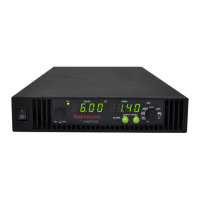
Do you have a question about the Ametek Sorensen XG 150-10 and is the answer not in the manual?
| Brand | Ametek |
|---|---|
| Model | Sorensen XG 150-10 |
| Category | Power Supply |
| Language | English |
Cautionary advice regarding high energy levels and potentially lethal voltages present in the power supply.
Warning about operating the power supply in flammable environments and unauthorized modifications.
States the XG Family DC Power Supply is not for life support or medical equipment.
Details the features and options available for the XG Family Programmable DC Power Supply.
Outlines the fundamental steps required for setting up the power supply, referencing relevant sections.
Explains how to configure settings using the 9-position mode control and rotary adjust/enter control.
Details the three operating modes: Constant Voltage (CV), Constant Current (CC), and Constant Power (CP).
Provides instructions on how to enable and disable the main output power of the supply.
Details the Constant Power mode operation for units with firmware version 2.21 and higher.
Explains various conditions that can cause alarms and the order of precedence for alarms.
Provides methods for clearing triggered, manual, and flash failure alarms.
Describes the OVP circuit and how it protects the load from over-voltage conditions.
Guides users on setting the over voltage protection (OVP) trip point.
Explains the UVP feature, which prevents voltage settings below a set value.
Guides users on defining the under voltage protection (UVP) set point.
Details the OCP alarm, configurable via the SCPI interface.
Explains how to perform a soft reset to clear parameters to factory default values.
Details how to operate power supplies in series for increased voltage or parallel for increased current.
Explains how to control output voltage and current using analog input sources.
Introduces isolated analog programming using the ISOL connector.
Provides information on setting up hardware and connections for different remote interfaces.
Details the steps for configuring remote control using the RS-232 interface.
Explains how to configure remote control using the USB interface.
Guides users on installing necessary drivers and setting up the PC for USB connection.
Reviews standard SCPI status reporting and XG-specific reporting.
Describes the operation status register containing information on normal operation conditions.
Details the questionable status register storing information about questionable events or status.
Describes the Reset command for performing a device reset to factory default states.
Explains the *CLS command to clear all Event Registers, Status Byte, SESR, and Error Queue.
Describes how to lock and unlock the front panel to prevent unauthorized changes.
Explains how to execute stored programs for automating sequences.
Covers foldback protection, loop protection, and interlock functions.
Intended for network administrators to configure and maintain devices on a network.
Explains how power supply functions are programmable over LAN/Ethernet if the option is installed.
Presents three connection choices for remote control: LAN, direct to PC, or private network.
Covers communicating with the power supply when the PC is on the same or different side of a router.
Covers setting required LAN information via Ethernet, serial/USB, or web interface.
Explains how to set a static IP address through Ethernet, USB, and Serial interfaces.
Lists system commands controlling level functions of the power source.
Describes XG's compliance with LXI version 1.2, Class C and its features.
Illustrates gain error and offset error as sources of analog programming error in calibration.
Details the first step of calibration: adjusting gain to intersect ideal and real lines at 90%.
Details the second step of calibration: adjusting offset to intersect lines at 10%.
Details the third step: repeating gain calibration for best results.
Explains that calibration data is stored using CAL:STOR and can be restored using CAL:REST.
Details gain and offset calibration procedures for the output voltage.
Details gain and offset calibration procedures for the output current.
Step-by-step guide for performing gain calibration on the output current.
Step-by-step guide for performing offset calibration on the output current.
Details the procedure for calibrating the over voltage protection (OVP).
Covers calibration for non-isolated APG voltage and current monitoring.
Guides users on calibrating the non-isolated voltage monitoring output lines.
Guides users on calibrating the non-isolated current monitoring output lines.
Details calibration for non-isolated voltage programming of voltage.
Guides users on calibrating non-isolated resistive programming of voltage.
Details calibration for non-isolated voltage programming of current.
Guides users on calibrating non-isolated resistive programming of current.
Covers calibration procedures for isolated modes: voltage monitoring and current monitoring.
Guides users on calibrating the isolated voltage monitoring output lines.
Guides users on calibrating the isolated current monitoring output lines.
Details calibration for isolated voltage programming of voltage.
Guides users on calibrating isolated resistive programming of voltage.
Details calibration for isolated voltage programming of current.
Guides users on calibrating isolated resistive programming of current.
Explains how to calibrate the VAP APG input gain and offset.
Explains how to calibrate the CAP APG input gain and offset.
Provides emergency shutdown steps: turn off, disconnect mains, disconnect load.
Provides steps for diagnosing and troubleshooting unusual or erratic power supply operation.












